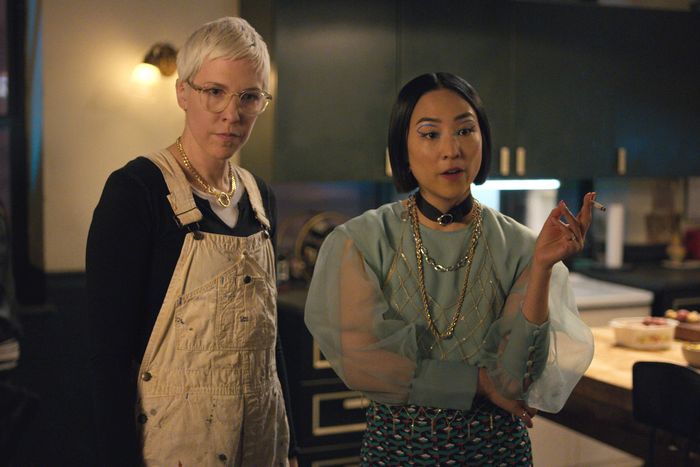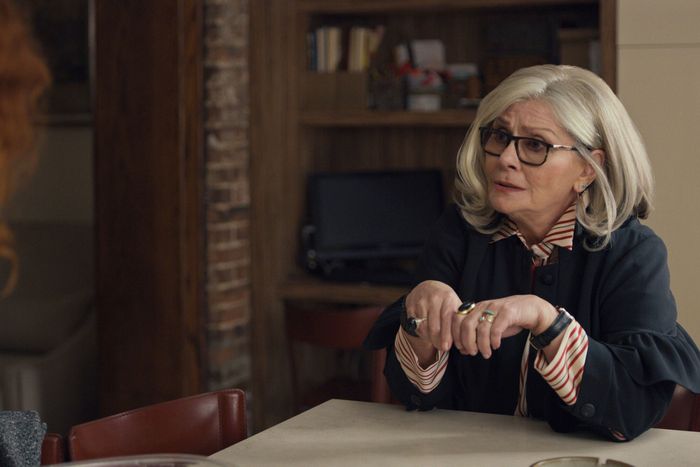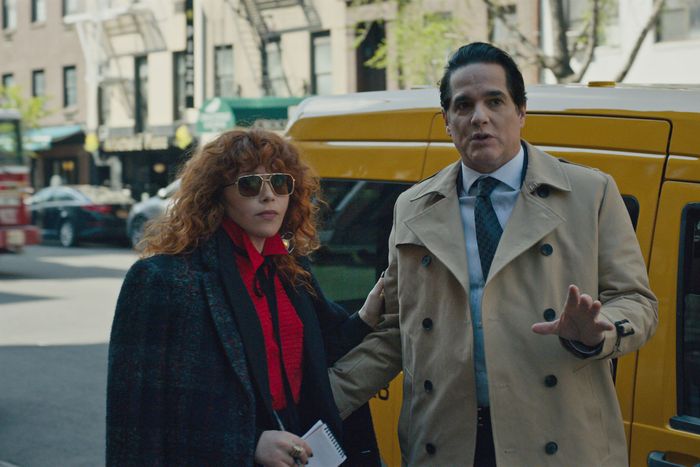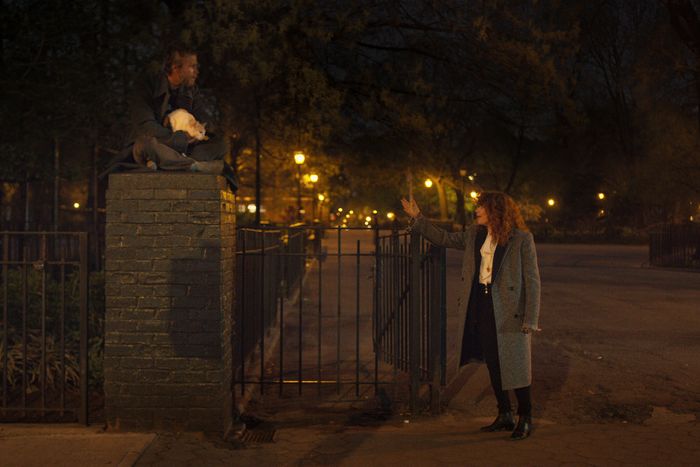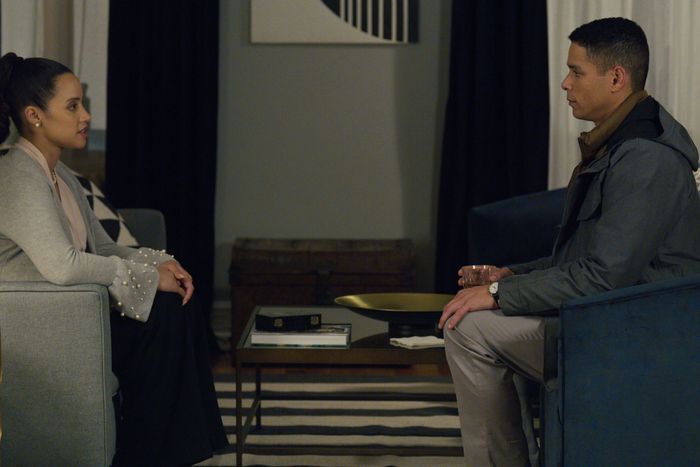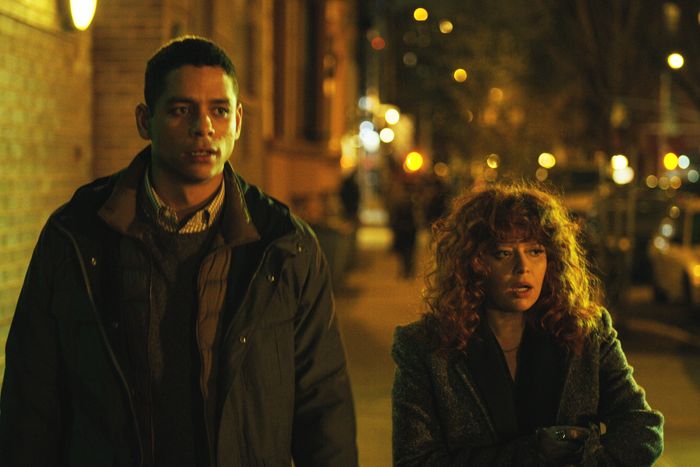
You’re not caught in a time loop — Russian Doll is back for another season of existential crises, odd-couple shenanigans, and glorious curls, three years after telling a perfect, seemingly closed-ended story. The first season of the Netflix series was centered on Nadia (Natasha Lyonne), a flinty but bighearted game designer, and Alan (Charlie Barnett), her tightly wound companion in cosmic weirdness. For reasons unknown, they die and “reset” a couple dozen times on the night of her 36th birthday, so this “girl with a death wish” and “broken man” must come together to escape their never-ending night and learn to let go of what they think they can control about this world.
Season two trades the temporal looping for a different time-bending conceit, but personal connections remain as significant as ever, often setting off a new cascade of revelations. As you prepare to dive into the new episodes, here are the key relationships to remember.
Nadia, Maxine, and Lizzy
The raging birthday party that backdrops much of season one is hosted by Nadia’s friend Maxine, an artist with a knack for extravagant shindigs and vaginal décor. “Sweet birthday baby” aside, Max and Nadia have a somewhat thorny relationship; their interactions at the party range from sweet to heated, especially when Max throws out the dreaded “crazy” characterization. Clearly they know each other well enough to know how to hurt each other. And it’s Max’s choice in party favors, i.e., the cocaine-laced joint, and abode (she lives in a former yeshiva) that jump-start Nadia’s investigation into what she initially believes to be a hallucination but turns out to be something even less tangible.
Lizzy isn’t as invested in the party or the chicken or even the custom bathroom door, but she reveals one of Russian Doll’s key themes early on while gamely assisting Nadia down the fire escape: “The key is knowing who to ask for help.” Though she designs one-player games, Nadia doesn’t move through the world entirely on her own. The more she engages with others — friends, drug dealers, the unofficial mayor of Tompkins Square Park — the more she learns about her predicament and the way out of it.
Nadia and Ruth
It’s quickly established that Ruth is a therapist, but that’s not the role she plays in Nadia’s life — she was a close friend of Nadia’s late mother, Lenora, and now serves as a surrogate parent to the brassy New Yorker. “Nothing in this world is easy except pissing in the shower” is the second thing Ruth says in the entire series, and it speaks volumes about her relationship with Nadia, now a whiskey-voiced wiseacre of her own accord. Ruth offers Nadia love and greater stability; at a crucial moment in the show, she reminds Nadia of a time when she yearned to be part of life rather than anesthetizing herself with drugs and sarcasm.
As their shared backstory is explored and we learn more about Lenora, Ruth’s presence expands. When Nadia fears she is showing signs of mental illness, Ruth arranges for her to go to Bellevue, only for Nadia to have a moment of clarity: “No one locks us up.” The show’s darkest moment sees Ruth shoot Nadia to death because she mistakes her for a robber. In the wrenching aftermath, Nadia realizes that her deaths — and actions — have far-reaching effects. It’s not a sense of shame she develops but a feeling of responsibility and interconnectedness.
Nadia and John
For much of the season, Nadia acts like she’d rather fall through another set of sidewalk cellar doors than revisit her relationship with ex-boyfriend John. And yet he can’t let her go — he shows up under the most dubious of circumstances, such as posing as Nadia’s husband to ask a rabbi about the yeshiva. John is trapped in his own cycle of thinking that he can make it work with her. As the rabbi tells him, “Buildings aren’t haunted; people are” — a line that resonates throughout the series.
Nadia is ultimately more motivated by a broken promise to John’s daughter, Lucy: When Nadia was still with John, she was supposed to meet him and Lucy for breakfast, but she backed out despite her own experiences with adults letting her down. To make things up to Lucy, she literally risks her life in order to retrieve a copy of Emily of New Moon from Ruth’s house, and delivers it at a breakfast not unlike the one she missed. This late-season meeting causes a seismic shift, as Nadia learns to “let go” of her mother’s shortcomings in order to “get free.”
Nadia, Alan, and Horse
“I think I know that guy.” Before the time loops begin, Nadia is already feeling déjà vu when she sees Horse, an unhoused man who has set up camp in Tompkins Square Park. However, Horse is a puckish character (he may even be a stand-in for the god Pan) and refuses to confirm or deny their relationship. Nadia shows him great tenderness, watching over him while he sleeps in a shelter (to make sure his boots aren’t stolen), letting him cut her hair, and even gifting him her prized Krugerrand necklace. Her instincts prove right, as her trip to the shelter leads her to Alan, the only other person in the world (we think) experiencing what she is.
Alan has his own interactions with Horse that are mostly harmless — though it’s still unclear what the latter means by “We got one” when he introduces Alan to a group in the park. Nadia arrives before we can find out, but Horse seems to represent nature, which is neither good nor evil. In the season’s final moments, he leads the nighttime parade that sweeps up Alan and Nadia, and both appear recommitted to living their lives fully.
Nadia and Lenora
Like a repressed memory, Lenora appears in bits and pieces, then all at once. Nadia hardly speaks of her, even to Ruth. When Alan puts Nadia’s photos of Lenora on display, she’s so incensed she kicks him out of her apartment, even though both know they “need each other,” as Alan says, to solve the mystery.
A flashback shows a young Nadia trying to help her mother through an episode as Lenora crows that this is the day they “get free.” It’s harrowing, though it’s the sight of her younger self in the present that kills Nadia three times in a row. Her real torment comes from believing she caused her mother’s death by choosing to live with Ruth; in order to break out of the time loops and her other fatalistic cycles, Nadia has to let go of the guilt she’s carried all her life.
Alan and Beatrice
Alan’s purgatory theory doesn’t pan out as the explanation for all the temporal funkiness, but you can’t blame him for trying. After all, his longtime girlfriend is named Beatrice, like the character from Dante’s Purgatorio, and though it takes him a while to admit it, their relationship makes a pretty good case for being stuck in limbo. From the outside, they seem well matched: They’re childhood sweethearts; Beatrice is an elegant Ph.D. student and Alan is a dedicated boyfriend. But having a plan doesn’t ensure happiness or even peace, as Alan realizes he’s “stuck with a body that is broken, in a world that is literally falling apart, and a mind that wants to kill me.”
Once Alan listens to Beatrice’s side, we realize how much of a toll things have taken on her. Like Nadia with Lenora, Beatrice felt responsible for Alan, who also lives with depression and anxiety. She made the same choices as Alan for so long that her only way out was to sleep with Mike, the self-described “hole where a choice should be.” That’s the kind of self-destructive move Nadia would and does make, proving life’s not about avoiding choices but making more considered ones.
Alan and Dr. Zaveri, his mother
The source of Alan’s rigidity and depression is never really pinned down — he tells Beatrice he always believed that if he worked hard and “did everything right, this aching, gnawing feeling of being an absolute failure would go away.” But his relationship with his mother, Dr. Zaveri, certainly raises some questions. The day he meets Nadia in the elevator, he visits his mother at work, and she immediately worries about him skipping work “again.” She seems relieved, instead of happy, at the news of his engagement (even though he lies about Beatrice’s response). We don’t see much more of their dynamic, but it’s clear there’s just as much to mine from Alan’s past as there is from Nadia’s.


